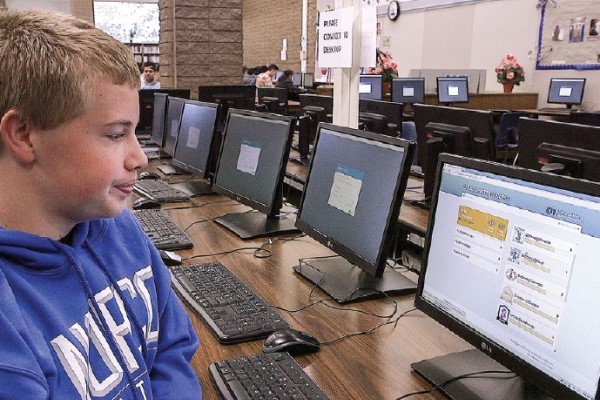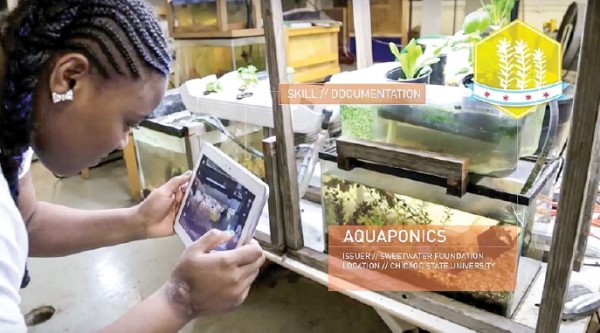Digital Badging
January 01, 2017
The practice of recognizing students' mastery of discrete skills with credentials so they can better communicate who they are and what they know.

Kids today are building their reputations in a much different world. They move seamlessly between offline and online networks, some with dozens of virtual peers who share similar interests, often spending hours together as they learn and share new skills. They create websites, produce movies and play video games where they earn badges and have followers and friends they may never meet face-to-face.
This new culture of reputation building often is linked inextricably with a new culture of learning. Today, an enterprising student may upload a series of video tutorials to help incoming parents learn how their school’s new online platform works. An introverted teen may be a guild leader in an online multiplayer game where her strategic thinking and communication skills are widely respected. The drama teacher may discover a student who is struggling academically has creative problem-solving skills learned in the library’s maker space that saved the school money on set design.
A Crossroads Credential
Are these skills and dispositions relevant in the 21st century? For many, the answer is yes, even if we have not yet honed assessments and credentials to consistently recognize them within the confines of our school settings. And yet, schools are bestowed with the responsibility to invest in students the character, knowledge and abilities they need to succeed as capable, employable adults.
It is precisely at this crossroads that open digital badges have emerged, representing a nexus of digital technology, assessment and recognition that borrows simple practices from the internet to create a new kind of credential.
What exactly is this new kind of credential?
Sometimes called “open” badges, these digital credentials essentially repurpose common technologies that we take for granted online. Imagine, for example, photos taken with a digital camera. Similar to an open badge, a digital photo contains not only the visual image but a packet of information, including the date and time and even the location where the photo was taken, the resolution and other metadata that are both human and machine readable.
Badges work the same way and can be designed to interlock with complementary technologies, including student information systems, personalized learning platforms and course management systems. Students 13 and older also can choose to share their badges on social media platforms.
A Wider Marketplace

Our schools already have grades, awards, trophies, ribbons and diplomas, and our students are among the most tested in the world. Do we really need more credentials? The straight answer is made more complex by this new culture of reputation building that pervades all aspects of 21st-century life. We look up information about each other online, whether for hiring, recruiting or simple curiosity. Digital badges are essentially a form of high-quality reputation that can be linked to criteria, assessments, evidence and testimonials, then stacked into educational pathways.
Trusted institutions such as schools, libraries, after-school providers and employers can endorse credentials to increase their credibility and validity. We call them credentials because that is the vernacular we use in schools, yet the underlying technology is simply a way for educators to help students tell a more rounded, compelling story about who they are and what they can do.
What sets them apart from traditional credentials is the relatively new practice of recognizing discrete skills and abilities that may occur in smaller units than the course curriculum. Badges offer students the opportunity to communicate more meaningful aspects of who they are and give educators the chance to recognize abilities beyond what is measured in a grade book.
Developing a wider ecosystem or marketplace in which these digital badges are issued, earned, shared and valued has been five years in the making. In 2014, I wrote What Counts as Learning: Open Digital Badges for New Opportunities, based on 30 Badges of Lifelong Learning projects that were among the first to design and implement digital badging systems.
These began as early as 2011. Since then, thousands of similar badging projects have launched in institutions of higher learning, workforce learning environments, out-of-school learning and K-12 schools. The school-based badging programs are among the most ambitious, and they include Michigan’s Merit Curriculum, one of the first statewide systems in which students can accumulate digital badges and credits required for high school graduation and early college success. These projects take place not only in traditional classrooms but also through after-school providers.
Teacher Growth
Schools also are experimenting with teacher professional development micro-credentials (see School Administrator’s November 2016 issue) before they pilot digital badging programs with students. We know youth are not the only group immersed in this new culture of reputation and learning. Teachers are expected to respond to instructional shifts that demand new competencies and skills, and school districts are struggling to provide high-quality teacher professional development in response.
Teachers in the Hancock Place School District in St. Louis, Mo., can earn badges by doing simple tasks such as learning MoveNote. This is a Google Chrome extension that adds voiceovers to slide presentations or quests that lead toward more advanced learning and certification goals.
The Houston, Texas, Independent School District has implemented a global learning initiative in 51 schools and offers teachers a globally themed customized badging platform with a community of peer educators provided by VIF International Education. Motivated to learn new skills, teachers are earning badges from Digital Promise’s catalog of more than 100 educator micro-credentials.
Other schools are using digital badges to connect learning both in and out of school. Five years ago, as word of open digital badges began to spread, administrators at Corona-Norco Unified School District in Riverside County, Calif., transformed their Passport to Success college-and-career-readiness program from a paper-based system to a badge-issuing platform. The district started with a small pilot of 12 badges issued to students in grades 4-12 who met specific mastery and achievement goals.
“We’re hoping to leverage the social component of badging,” says April Moore, director of education technology for Corona-Norco schools and a lead architect of the badging initiative. The goal, she adds, is to “move outside the box of our K-12 education system,” while looking for opportunities to embrace new styles of teaching and assessment introduced as part of the Common Core State Standards Initiative.

Sheryl Grant works with school
districts to connect student learning
inside and outside the schools’ walls.
Photo by Kaysi Holman
Scaling Systemwide
As California’s 10th largest school district, Corona-Norco serves 53,000 students at 49 schools across the communities of Corona, Norco and Eastvale, including three alternative schools. Having integrated a third-party badging portal with its existing student information system and experiencing initial success with early adopter schools, the district expanded the number of badges offered to students.
Successfully scaling the badge initiative across the large, diverse urban district required flexibility so that teachers could issue school-specific badges (such as agriculture) for programs offered at their sites. Each school now has a badging “ambassador” who helps develop badges with potential to motivate and recognize students based on the interests of their particular school.
As the program expanded, the district focused on badges that recognized growth in key subjects, including English learners who demonstrated proficiency and students who improved on standardized tests. More recently, the district added badges for completion of community service and other extracurricular experiences.
Corona-Norco currently issues 12 districtwide badges, 200 school-based badges, 26 active badge pathways and 162 active badges. To date, students have earned more than 600,000 badges, and the district recently opened the badging platform to community organizations such as the fire department to recognize students taking CPR courses.
“Our hope is to increase motivation from students who may not be motivated by a grade of A on their report card but are motivated by their peers,” says Moore. “Administrators noticed increased student knowledge and ownership of their educational pathways and what it takes to achieve the next badge or benchmark of a college-readiness indicator. Students are more active in the process rather than passive.”
As the badging initiative has entered its third year, Corona-Norco leaders are analyzing the data and gathering feedback to improve the program and pinpoint successful practices for motivating students.
Peer Influence
Early research by Corona-Norco district found one group responding enthusiastically to badges: video gamers in intermediate and high schools, predominantly pre-teen and teenage boys. “These students may not naturally see meaning and value in an A grade,” Moore says, “but they thrive on social, peer recognition and already understand the concept of digital badges and are, in fact, teaching their peers about them.”
Students are encouraged to display their badges alongside digital portfolios, demonstrating their skills to potential employers and universities. Meanwhile, district administrators have been meeting with industry partners, community leaders and local universities so these stakeholders understand the college and career readiness aspects of Passport to Success badges issued by Corona-Norco’s schools.
Author
Additional Resources
School districts interested in exploring digital badging can learn more about Corona-Norco’s College and Career Readiness Badges and Pathways at http://ccrpathways.forallschools.com.
To learn more about HASTAC, which developed and administered the Badges for Lifelong Learning initiative, access www.hastac.org/initiatives/digital-badges.
To learn how Missouri’s Hancock Place School District developed a professional development badging program for its teachers, access http://badges.hancock.k12.mo.us.
Other information sources are VIF International Education (www.viflearn.com) and Digital Promise (http://digitalpromise.org).
Advertisement
Advertisement
Advertisement
Advertisement



.png?sfvrsn=ffae7191_7)